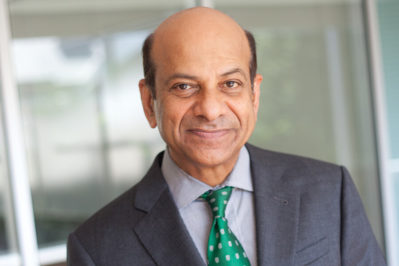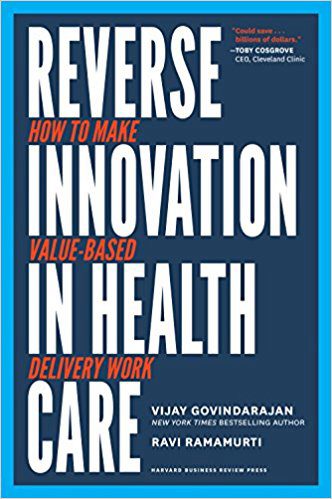Today, the cost of healthcare in America greatly outstrips the services that can be provided. In this episode of Mastering Innovation on Sirius XM Channel 132, Business Radio Powered by The Wharton School, Vijay Govindarajan, Coxe Distinguished Professor at Dartmouth College’s Tuck School of Business and author of Reverse Innovation in Health Care: How to Make Value-Based Delivery Work, discussed recent evolutions in India’s healthcare system, and how the U.S. can learn from it.
Without health insurance in America, a trip to the hospital can cause financial ruin. Vijay Govindarajan’s book documents how an open heart surgery in India can cost seventy-five times less than it does in the U.S. at the same high quality. He describes the flaws in America’s health care system, primarily its high costs, and provides concrete examples of how to improve upon them. Together, Singh and Govindarajan examine current industry changes, task shifting, and the misaligned financial incentives of health care in America.
An excerpt of the interview is transcribed below. Listen to more episodes here.
Transcript

Harbir Singh: You talk about Aravind Eye Hospital, which has very good patient outcomes while having a much lower cost than comparable facilities in the U.S. My question is, what are the barriers that prevent systems in the U.S. from adopting some of these things? There is such a huge incentive to get more efficient outcomes. You had a statistic that, among 11 industrialized nations, the U.S. ranked first in spending and last in performance. This is not a good report card at all; everybody knows that. What is the barrier?
Vijay Govindarajan: It’s a great question. Let me back up and say, in Washington, D.C. we debate the wrong question, whether it is Obamacare or Trumpcare or RamCare. Today, we are spending $3 trillion on healthcare. The question we ask in Washington, D.C. is, “Who’s gonna pay for what?” It is an insurance question. The high cost of insurance is symptomatic of the fundamental problem: our healthcare costs are too high.
“The U.S. system doesn’t provide the right incentives to adopt healthcare delivery innovations.” – Vijay Govindarajan
Singh: Both of us teach strategy, and the locus of competition may well be in the wrong place in the U.S., which is on the payers’ side and not on the delivery side. If you don’t have the locus of competition on the delivery side, then you don’t get the value proposition there. Michael Porter, in another piece of work, kind of went in that direction as well. I’m sure you have comments on that.
Govindarajan: Without a question. What we really need is to reduce the healthcare cost, and that requires healthcare delivery innovations. The question is, why is it not happening right now? In the U.S., while we may say we are incurring very high cost, the system doesn’t provide the right incentives to adopt healthcare delivery innovations to reduce costs because the system currently is fee for service. So, a hospital gets reimbursed based on fee for service.
Singh: On categories rather than on the outcome, right?

Govindarajan: Yes, exactly. The more services you provide, the more fees you can collect. Therefore, it incents you on volume of services rather than the value to the customer. We have so much overbuilt capacity in hospitals in the U.S., and they are hungry for volume. The incentive promotes them to utilize the hospital facility instead of really promoting patient outcomes. There is a perverse incentive. There is lack of price transparency. The customer doesn’t pay and the hospital has incentive to collect. Insurance companies are incented to charge high premiums. There is something wrong with the system.
Singh: Fascinating. Yes.
Govindarajan: Having said that, it is an excuse to say, “There is a system problem; therefore, I cannot take any kind of actions to really drive down healthcare costs.” There are examples even within the U.S.’ current regulatory system. The University of Mississippi Medical Center is a good example. Iora Health is another hospital chain that we studied. These are all operating in the same development system.
Govindarajan: In the U.S., they’re able to adopt Indian-style innovations. Iora Health has adopted task shifting. I have switched my primary care to Iora Health because in Iora Health, for every primary care physician, they have five health coaches; these health coaches are community workers. They have dramatically lower costs. The health coach works with the patient to really enforce adherence to the prescriptions.
“It is an excuse to say, “There is a system problem; therefore, I cannot take any kind of actions to really drive down healthcare costs.”” – Vijay Govindarajan
Basically, the problem in primary care is if you’re obese, you go to a primary care doctor and he asks you to follow certain diet medication. If you don’t comply with them, you don’t solve the problem. If someone is obese, these health coaches go to the person’s home and sit with them and say, “How are you spending your time? You’re watching TV 10 hours a day and you’re eating potato chips.” They go with them to a grocery store and see how they shop and say, “Instead of using this high-fat yogurt, why don’t you use this option which tastes equally good?” It is about changing people’s behavior.
Singh: Vijay, you were making a very important point about the preventive nature and maybe a more holistic approach to dealing with the patient, right? Maybe that would spark preventive healthcare at a lower ticket, but also with better outcomes.
Govindarajan: Exactly. I was giving the example of Iora Health because they focus on primary care so that you spend less on secondary care and tertiary care. Even with the primary care focus, they have adopted a task-shifting model with the result that they are able to provide primary care at a very low cost. because, for every primary care physician, they have five health coaches. Those health coaches are recruited not for medical training, but for empathy, people skills, etc. I switched to Iora Health after this research. My health coach used to work in a Dunkin’ Donuts and he is the most fascinating person. You can teach someone how to take blood pressure and so on and so forth, but you can’t teach someone empathy.
Singh: Interesting.
Govindarajan: They can do it within the current regulatory framework. This country, America, is known for bottom-up innovation. That’s what we’re good at.
About Our Guest
Vijay Govindarajan, known as VG, is widely regarded as one of the world’s leading experts on strategy and innovation. VG, NYT and WSJ Best Selling author, is the Coxe Distinguished Professor at Dartmouth College’s Tuck School of Business. He was the first Professor in Residence and Chief Innovation Consultant at General Electric. He worked with GE’s CEO Jeff Immelt to write “How GE is Disrupting Itself,”, the Harvard Business Review (HBR) article that pioneered the concept of reverse innovation – any innovation that is adopted first in the developing world. HBR picked reverse innovation as one of the Great Moments in Management in the Last Century. In the latest Thinkers 50 Rankings, Govindarajan was ranked the #1 Indian Management Thinker.
Govindarajan has been repeatedly identified as a Top 5 management thinker by influential publications including: Outstanding Faculty, named by Business Week in its Guide to Best B-Schools; Top Ten Business School Professor in Corporate Executive Education, named by Business Week; Top Five Most Respected Executive Coach on Strategy, rated by Forbes; Top 50 Management Thinker, named by The London Times; Rising Super Star, cited by The Economist; Outstanding Teacher of the Year, voted by MBA students.
Mastering Innovation is live on Thursdays at 4:00 p.m. ET. Listen to more episodes here.



